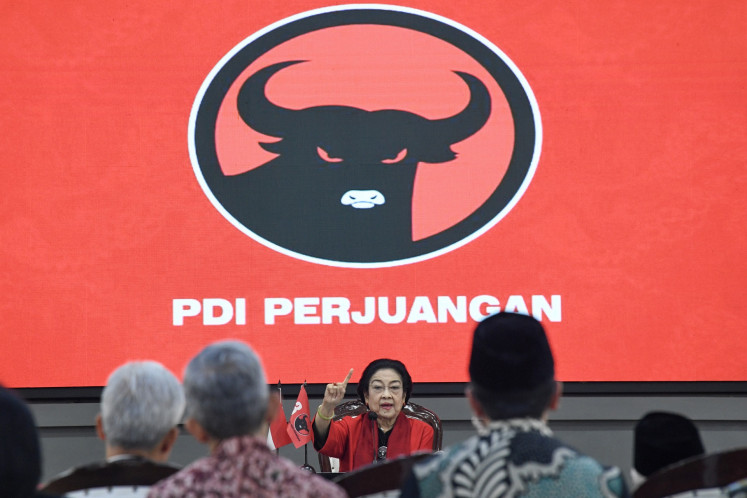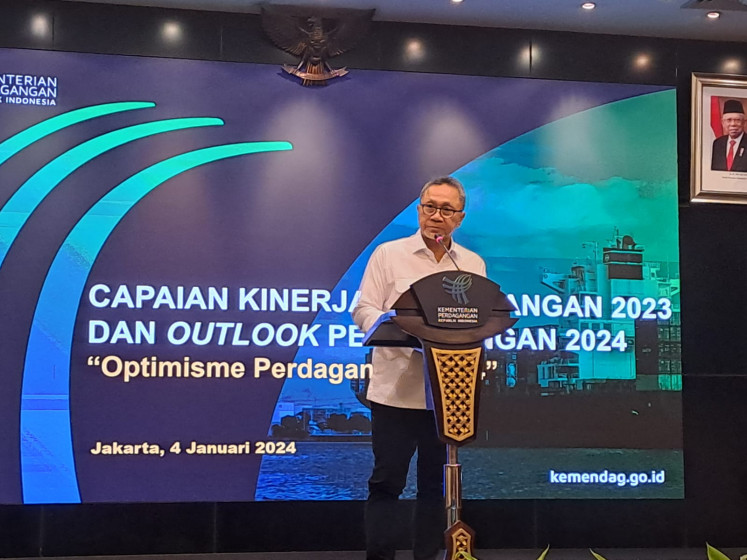Adapting local wisdom key to Jakarta’s flood control: Experts
The extreme rainfall that hit Jakarta at the start of the year seems to have eased in the past weeks, but flooding remains in some parts of the capital after normal downpours
Change Size

T
he extreme rainfall that hit Jakarta at the start of the year seems to have eased in the past weeks, but flooding remains in some parts of the capital after normal downpours.
Residents of Kebon Pala in Kampung Melayu and Tengah in Kramat Jati in East Jakarta were hit by floods up to a maximum of 1 meter in depth on Tuesday.
Amid the never-ending debate about whether river “normalization” or “naturalization” projects are better, some experts have urged policymakers to shift from such a conventional approach focusing on hard infrastructure to flood adaptation.
Living in harmony with floods is crucial to reducing damage, according to Adam Madigliani Prana, a PhD student at the University of Canterbury, New Zealand. Flooding is not an unusual phenomenon for the city, even since the Dutch colonial era.
Adam, who is doing a doctoral thesis on communities adapting to flood-prone environments, cited a book written by urban development experts Kelly Shannon and Bruno de Meulder in 2013.
The canal system that was built in Batavia — the old name of Jakarta during the Dutch colonial rule — and which removed water from the city and covered riverbanks in concrete, is unsuited to the city’s geography.
The heavy flow and high turbidity of Jakarta’s rivers, in combination with water-impermeable infrastructure, leads to a greater risk of flooding because of faster silt-up, Adam said.
“Building canals is a faster way to avoid flooding but climate change will lead to a higher water flow rate in the future. [Canals] protect us this year, but we may have to widen [the rivers] next year, making the program unsustainable,” Adam said on Wednesday.
Adam said several communities had in fact adopted “harmonious living” with floods, citing as an example Kampung Kerang Ijo in Muara Angke, North Jakarta.
The residents, many of whom are mussel farmers, have built bamboo-stilt houses and reclaimed land by building mounds from mollusk shells, making it permeable to excess water from coastal floods. The land is also strong enough to hold the weight of a car, thus supporting their need for vehicle access.
He also cited an example of Kampung Kerapu, also in North Jakarta, where people build at least two-story buildings to provide more infiltration areas on the ground.
“The idea is to have a mechanism that allows the adoption of local knowledge rather than methods from other countries,” Adam said.
“Other regions might have different resources and mechanisms of adaptation,” he added.
He said the paradigm of “accepting water” should not only be applied by those living along the riverbanks but the public as a whole.
A similar opinion was expressed by Indonesian Institute of Sciences (LIPI) researcher Gusti Ayu Ketut Surtiari, whose previous research focused on the effectiveness of numerous adaptation programs related to disaster-risk reduction.
“Adaptation efforts range from house modification to those related to early-warning systems at the local level. It can also be implemented in drainage systems in residential areas to ensure they connect to the wider networks to prevent water blockages,” she said.
She highlighted the importance of implementing local wisdom given that locals knew their own neighborhoods best.
“Adaptation strategies must consider local conditions and histories. An adaptation strategy has no universal model,” she said.
Support from the government, both in terms of regulations and financial backup, is essential to realize this strategy. Participation of private companies operating in the flood-prone areas is also preferable, she said.
Adam, meanwhile, also suggested that the Jakarta administration should create greater access to public participation in its spatial planning and policies.
“[It is about] how the city spatial planning allows mechanisms to explore and accommodate customary knowledge of local communities. The participatory planning concept in Indonesia is still merely a formality,” he said.
Jakarta Governor Anies Baswedan has introduced a series of programs to improve the quality of life in slums, some are situated in flood-prone areas. However, the legality of land ownership remains a major obstacle to these programs because many slum dwellers do not have legal claims over the areas they occupy.
Jakarta Water Resources Management Agency head Juaini Yusuf said public involvement in flood control mainly relied on kerja bakti (community work) programs — mostly in the form of efforts to build infiltration wells.
“This year, the agency maintains its routine activities, including dredging rivers and reservoirs, as well as procuring land [for normalization and naturalization projects],” he said on Wednesday.
The Public Works and Public Housing Ministry has managed to build only 16 out of 33 kilometers of planned river embankments since the normalization project was first introduced in 2013. The sluggish progress of land acquisition by the Jakarta administration has forced some of the projects to halt.
Anies’ flood management program, so-called naturalization, meanwhile, is underway in five locations across the capital, namely the West Flood Canal and part of the Ciliwung River on Jl. Krapu, as well as in three reservoirs in South Sunter, Cimanggis and Kampung Rambutan.
These projects aim to develop public spaces on the riverbanks and the edge of reservoirs. Facilities in the public spaces would vary depending on the location, such as a jogging track or benches.
“Naturalization brings people closer to the water,” said Yose Rizal, an official from the city’s water resources agency in charge of the naturalization projects.









